Daniel Lord, SJ, the Restless Flame:
Supporting Catholic Families
By Stephen A. Werner, Ph.D.
(Originally published in Human Families: Identities, Relationships, and Responsibilities: College Theology Society Annual Volume 66 2020 (Maryknoll, NY: Orbis Books, 2021), 48-58. Reprinted with permission.*)
Daniel Lord, SJ (1888-1955), one of the most influential Catholic religious figures in the United States in the early twentieth century, was also the most productive.1 He spent his entire life finding creative ways to share and teach his religious faith. As he wrote: “If the world would only live by Christ's teaching, what a happy place it would be!”2 Lord rejected a dour, moralistic, Jansenist-type religion emphasizing human sinfulness and the need for constant repentance. Although such attitudes were common in much of the American Catholic Church, Lord's key assumption was that Christian faith (for him the Catholic faith) was the way to moral goodness and happiness.3 He wanted to educate, encourage, and support Catholics of all ages. In the process, he worked to support healthy Catholic families.
Lord's Background
Lord grew up in Chicago and went to St. Ignatius High School and College—later Loyola University. He joined the Jesuits at St. Stanislaus Seminary outside of St. Louis. Ordained in 1923, in 1925 he was assigned to become national director of the Queen's Work office in St. Louis, which promoted the Jesuit Sodality movement. Sodalities were religious clubs at Catholic high schools and colleges; many parishes had both a women's sodality and a men's sodality. At their peak, 13,000 sodalities existed across the United States and Canada. Lord built up the movement and created the materials needed to guide sodalities, such as sodality manuals. Further, he published The Queen's Work magazine. Here, a key member of his staff, Edward Dowling, SJ (1898-1960), would play a central role in promoting Cana conferences to educate Catholics on marriage. Moreover, Dowling greatly influenced Bill Wilson, who (along with Dr. Bob Smith) created Alcoholics Anonymous.
Lord worked from a comprehensive vision, seeing faith, the Church, the moral life, Catholic social teaching, and Catholic families as part of a greater whole. He saw the sodalities as a way to strengthen the relationship among these elements in the life of faith.
Lord's Popular Writings
Lord felt the need to educate people about their Catholic faith. How could he do that with sodalities all over the country? Lord saw pamphlets as the answer. Lord was in part motivated by the success of the E. Haldeman-Julius Publishing Company of Girard, Kansas, publisher of Little Blue Books, which ran from 1919 to 1978 and sold over 300 million copies. Little Blue Books covered philosophy and literature, but also salacious subjects such as The Love Affair of a Priest and a Nun and anti-religious subjects such as 61 Reasons for Doubting the Bible and Why I Reject the Idea of God.4
To be ideal for reading in a few spare moments, such as while on a streetcar or bus, Lord's pamphlets had to be small enough to fit in the pocket of a man's suit coat or in a woman's purse. Many of Lord's pamphlets had clever cover graphics. In thirty years, Lord wrote and published 228 pamphlets, printed and distributed through the Queen's Work office and its sodalities. Pamphlet racks were also sold and these wound up in schools, churches, and even on ships during World War II. Pamphlets by other Jesuits and Catholic writers were also published. Lord's pamphlets covered many categories, including vocations, dating, marriage and family, Christmas, apologetics, sacraments, the church, current events, Catholic devotions, and personal guidance.
Lord avoided overly religious titles that might make a young person reluctant to read them in public. Some Lord titles are cute: Are You a Well-Balanced Person?; Diet Can Be Fun; andOh! Not in My Pew. Many pamphlets reflect the mores of the times: Spinsters Are Wonderful People; So We Abolished the Chaperone?; Why Leave Home?; Let Me Lead My Own Life!; Nobody Loves a Tease; and Politeness in the Pews. Often his titles were ironic: There's Money in Gambling; Fashionable Sin; These Terrible Jesuits; I Don't Like Lent; The Church Is Out of Date; What Catholicity and Communism Have in Common; and Thanks to the Communists.
Altogether, Lord's pamphlets sold over twenty-five million copies, and the pamphlets by other writers sold another fifteen million copies. 5 One of Lord's pamphlets, Confession Is a Joy?, sold 340,000 copies.
For his dialogue pamphlets, Lord created the character of Father Hall, a priest and writer, who had regular visits from Catholic, college-aged twins named Dick and Sue Bradley, with whom he would discuss religion and moral issues. Lord never defined the ideal Catholic family—he was not a theorist—rather he created a model in Dick and Sue Bradley and their parents. The fictional Father Hall also had visits from Ford Osborne and Helen Webb, two young self-described “pagan” skeptics, who expressed criticisms against religious faith; providing Hall an opportunity to defend his beliefs. Similarly, in The Queen's Work, Lord ran a regular piece on Joe College discussing issues with his skeptical, non-believing friend: Chick Pagan.
Lord on Dating and Marriage
In his long career, Lord produced a significant body of writing on dating and marriage, read by many hundreds of thousands. Writing for ordinary people, not academics, Lord did not include footnotes and bibliographies. He was a voracious reader, yet there is no way to know what he read. Perhaps he read the influential writings of Dietrich von Hildebrand (1899-1977) such as Marriage: The Mystery of Faithful Love (1929) and In Defense of Purity: An Analysis of the Catholic Ideals of Purity and Virginity (1931), or the 1939 book of Herbert Doms (1890-1977), The Meaning of Marriage? Surely, Lord read the 1930 encyclical of Pius XI, Casti Connubii, on the sanctity of marriage, but he did not quote it. Although some of what Lord wrote is dated, much of it is insightful and highly relevant today. He was a visionary in the concept of teaching young people about dating and relationships and educating men and women about how to have better marriages.
Lord wrote six pamphlets on dating and romance, two books and fifteen pamphlets on marriage, four pamphlets on birth control, and two pamphlets on divorce. Lord's pamphlets on dating were What to Do on a Date (1939, sold 294,000 copies!); Why Be a Wallflower? (1940); Going Steady (1941); So We Abolished the Chaperone? (1941); I Was Going Steady: A True Story With or Without a Moral (1948); and Romance Is Where You Find It (1947). His books on marriage were Questions I'm Asked about Marriage (1939) and Planning Your Happy Marriage (1949). Moreover, Lord's outstanding pamphlet They're Married! (1929) is filled with gems of his insights about marriage. Its treasures include:
The church has been called in scorn an idealist, as if that were something to be ashamed of. She is an idealist. 6
The lovely maiden who always looked like a fresh-blown rose takes to bedroom slippers, an easygoing dressing gown, curlers, and a mask of cold cream. The beauty and the gallantry that were so thrilling during the courtship and the honeymoon seem pretty second rate often under the cold light of the living room lamp or the relentless sun that beats down in the family car picnic-bound.7
Love is blind, right enough but it begins to recover its eyesight about the time the bridal bouquet is thrown into the ash pit and the groomsman notices his first soot speck on his dress gloves.8
Marriage is a contract between men and women who were never superlatively good at anything they attempt and who bring to the contract neither the patience of horses nor the perfect justice of Angels. The men and women who expect marriage to be flawless are the very same ones who make mistakes in everything they do and make before any enterprise allowances for the mistakes that are bound to mess it up.9
The church knows that marriage is as difficult as human nature—more difficult in fact.10
Marriage does not work any miracles in dispositions, and we know dispositions only when we see them without the defenses of the studied politeness and a careful guard. The lovers' defenses are oftenest down in their own homes.11
Lord's productivity was driven by his contact with young people through the sodalities at schools and with adults through his many lectures. Many pamphlets responded to issues they raised. Three books came directly from “question boxes” at Lord's lectures: Questions I'm Asked about Marriage (1939); Questions I'm Asked about Religion (1939); and Questions People Ask about Their Children (1948). Lord also had extensive personal correspondence with countless people. He knew the issues they struggled with. For example, Lord was adamant in arguing against young people drinking alcohol in social situations. He had read too many letters describing bad decisions, heartbreak, and tragedy involving young people under the influence. Although he never used the term “date rape,” he was clearly aware of the phenomenon.
Lord believed that Catholics should marry other Catholics.12 In Marry Your Own (1929) and Don't Marry a Catholic (1952), Lord spoke out strongly against religiously mixed marriages: “Don't you know that the greatest source of fallen-away Catholics is mixed marriages?”13 The title In-Laws Aren't Funny (1948) came from Lord's day, when mother-in-law jokes were the bread and butter of many comedians on radio, and later television. Lord gave practical advice for proper boundaries for in-laws.14
To young women, Lord suggested they could gain an idea of how a man will treat his wife by looking at how he treats his mother. He also suggested boys look at girls' attitudes toward their own homes. Lord believed such observations helped one assess how one's love interest might be as a spouse. Your Partner in Marriage (1936) describes some young women as anxious to marry: “They snap at a possible catch like a hungry trout at a fascinating fly, paying little heed to the possible presence of a barb beneath the glowing colors.”15 “Brilliant beginners are beyond count. Those who achieve ultimate success are few indeed.”16 Your Partner in Marriage would sell over 218,000 copies and go through 32 printings. Money Runs or Ruins the Home followed in 1942 and then Grow Up and Marry: An Interview with Raphael C. McCarthy, S.J., in 1945.
His pamphlet Love's All That Matters (1948) would sell 137,000 copies. Here Lord rejected misconceptions about romantic love:
The preoccupation with romantic love, the conviction that “if I miss this love, I shall never know another,” rests on a strange fallacy. Somewhere in relatively recent times there grew a notion that two specific people were made for each other, these two and these two only. Marriages are not confirmed in heaven through the sacrament of Christ's institution; marriages are arranged in heaven. It is as if definitely assigned angels equipped with filing cards place in a certain bracket the cards of John and Jane ... and if for some reason John and Jane do not hit it off on earth, the angels have to tear up the cards and call off any possibility of Jane's and John's ever marrying anyone else.17
In God Bless the Newlyweds (1949) Lord explained the theology behind marriage and the wedding ceremony. M is for Marriage (1950) covered the five important M's: Mind, Money, Manners, Meals, and Morals. Lord wrote Sizing Up ... The Man of Your Choice: A Booklet for Girls with a Mind for Marriage in 1952 and The Girl Worth Choosing: For the Boy Who Chooses and the Girl Who Wants to Be Chosen in 1953. The latter pointedly asserted both that “A girl is not changed by marriage”18 and “Before marriage, not after, is the time to find out what sort of person the girl really is.'“19
Lord's Children's Books
Lord's attention did turn directly to families, however, in his perception of a need for quality Catholic children's books. Lord learned from his mother the importance of reading to children at an early age and encouraging children to read. Although common sense today, in his time this was a novel idea. In the 1940s and 1950s he wrote some seventy such books, including coloring books. Lord wrote The ABC of a Child of God (1942); The Great Deeds of Jesus (1943); and A Happy Child of God: A Catholic Baby Record Book (1946). Some of these sold millions of copies, and some are still being published today.
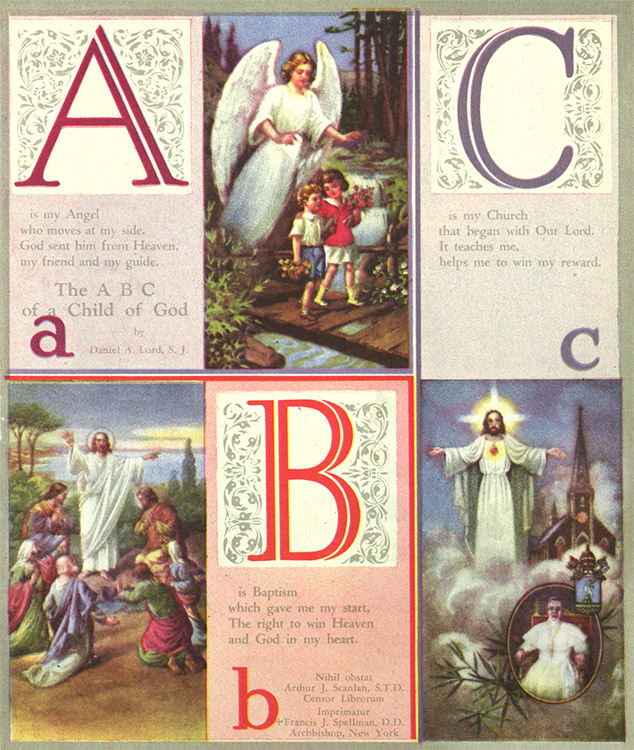
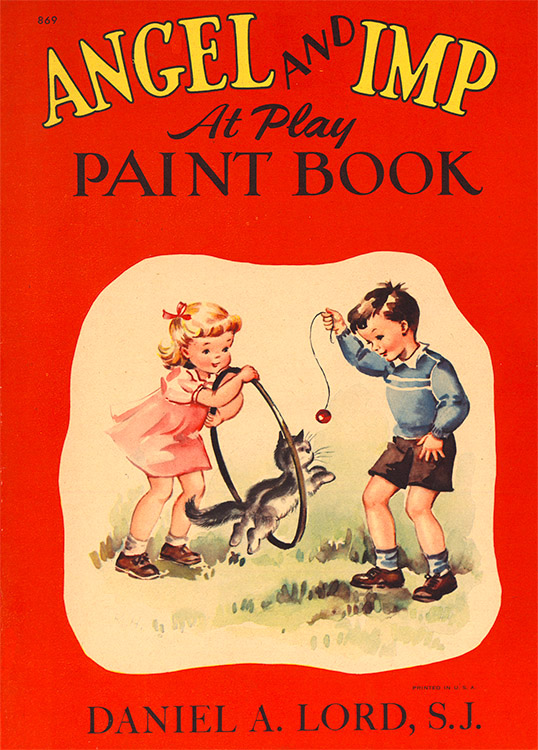
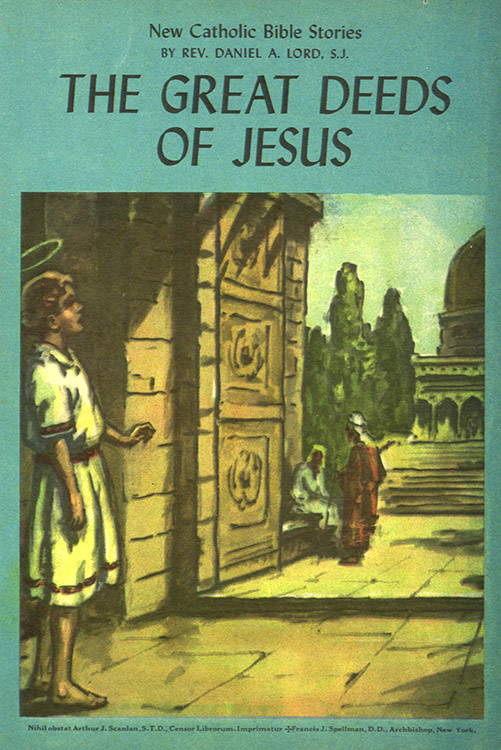
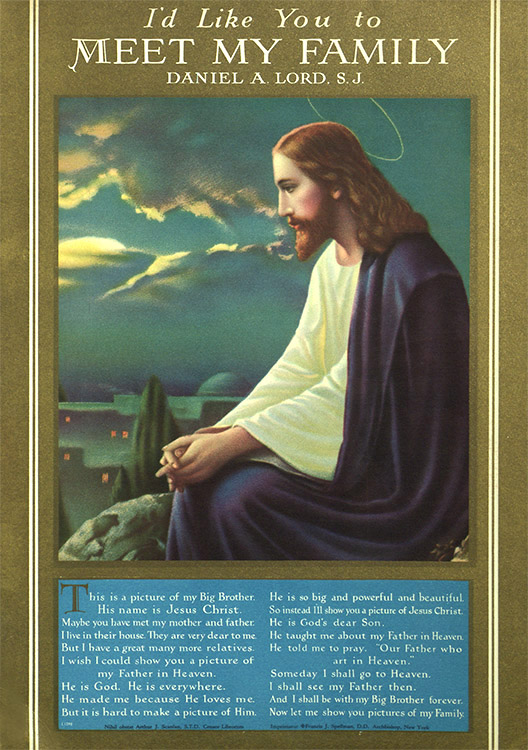
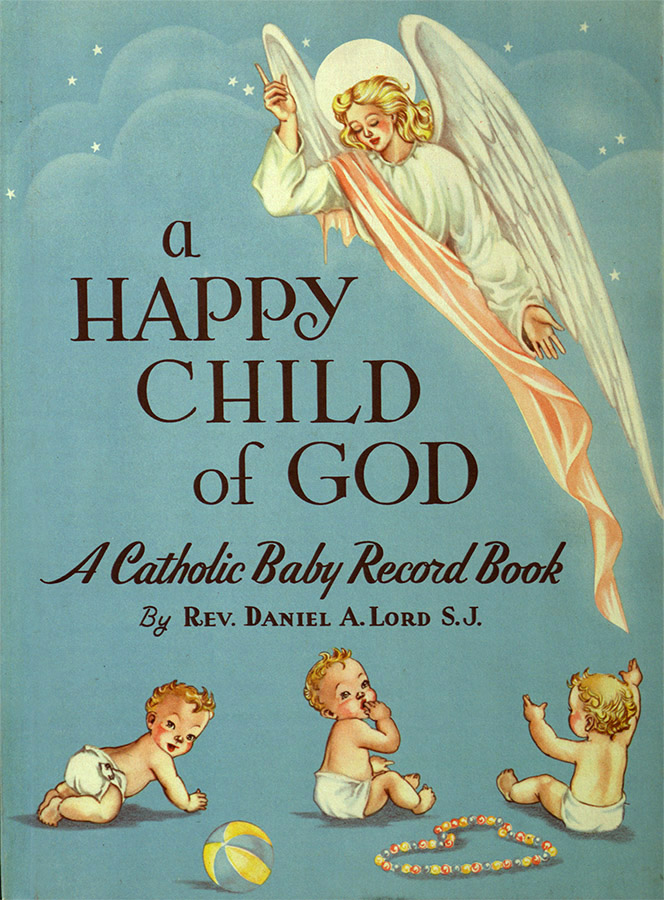
Lord's Moral Code for Movies
Despite his diversity and productivity as an author, Daniel Lord is best known for writing the controversial Motion Picture Production Code of 1930 (later known as the “Hays Code”), which Lord ultimately came to regard as a failure. Lord had been concerned that current movie content led people, especially young people, astray by glorifying crime and immorality. In Lord's thinking, movies often portrayed characters doing the wrong things in a way that drew sympathy from the audience. Such examples undermined the morality that Lord promoted in his writings and that he saw as key to happy lives and healthy families. In subsequent decades, through his personal contact and correspondences with many young people, Lord would continue to learn of heartbreaking stories of young people's lives damaged by reckless behavior modeled by movie characters.
Lord was not opposed to entertainment in general; in fact, he loved theater. He grew up with great live family theater, such as vaudeville, the most popular entertainment of the late 1880s and early 1900s. Vaudeville was a style of variety entertainment performed in circuits of theaters across the country, visited by traveling acts of comics, singers, and dancers. By 1930, vaudeville was dying, in part because so much of live theater had shifted from family content to adult content. Lord saw the same shift happening in movies, noting that Hollywood was all too willing to find reasons to include nudity and sexually provocative scenes. He recounts how the head of Warner Bros. Studios, Jack Warner (1892-1978), once commented that “whenever my directors are stuck for something to do, they make the heroine take off her clothes.”20 Lord feared that what happened to live theater would happen to the movies. In writing the 1930 code, Lord believed he was saving Hollywood from its attraction to base and crude content featuring dirty humor, female nudity, sex, and violence. Such content desensitized people to good stories and classic entertainment.2' And as he later noted, “Now in a combination of circumstances that is a little too pat for easy credulity, a lot of things congealed.”22
Creation of the Movie Code
In Chicago, Cardinal George Mundelein (1872-1939) had weekly lunches with officials of Halsey Stuart and Company, one of the largest financial firms in the country. Lord wrote, “Across the luncheon table the bankers told the cardinal how into their laps had been dumped the control of motion-picture companies. They were frankly shocked with what they now owned. They wanted no part of the crime and vice movies that were all too common from Hollywood.”23 The movie studios, in debt when the Great Depression started in 1929, defaulted on their loans, and the banks then wound up with control of the studios.
Others were also concerned about movie content. Martin J. Quigley (1890-1960), a Catholic, was the publisher of Motion Picture Herald, a professional magazine for movie theater owners and operators, which had become a guidebook for the whole industry. Meanwhile, Fitzgeorge Dinneen (1865-1944), a Jesuit priest at a Chicago parish, had been organizing boycotts of movie theaters showing films with what they deemed inappropriate content. Quigley and Dinneen discussed the problem. The chairman of the Motion Picture Producers and Distributors of America, Will Hays (1879-1954), already had a list of “Do's and Don'ts,” but the points were not organized. Martin Quigley believed that a better code for movies could be created. Quigley convinced Dinneen, who then communicated the idea to Cardinal Mundelein. Mundelein in turn proposed the idea to Halsey Stuart and Company. The bankers supported the idea but still needed such a code to be developed.24 In fall 1929, Dinneen invited his friend Daniel Lord to Chicago. “Far into the night,” Dinneen, Lord, and Martin Quigley talked about the code.
The code must be so written that the follower of any religion, or any man of decent feeling and conviction, would read it and instantly agree. It must make morality attractive, in the sense of responsibility of the movies to its public clear and unmistakable. It must be a matter of general principles and their immediate relationship to the practical plots in situations of the film. It must cover all the essentials and go far enough in the particulars as to be an easy guide for men who wanted to know precisely what was expected of them, how far they might be allowed to go, and how tightly they would be bound.25
Lord makes an important point here. Although many of the key figures in creating the code were Catholic, there was nothing specifically Catholic about the code itself. The moral principles behind the code were held by many Catholics, Protestants, Jews, and even by nonreligious people. Some later writers describing the history of the code refer to “Catholic theology” influencing the writing of the code, but none of it is theology. Rather it was built on traditional moral values held by many Catholics but also many others.
Lord returned to St. Louis where he alone wrote the code. Weeks later he returned the completed project to Dinneen and Quigley, who delivered it to Cardinal Mundelein and Will Hays, respectively.26 A key line in the code reads: “The sanctity of the institution of marriage and the home shall be upheld.”27
Pitching the Code
With Quigley, Hays set up a meeting with motion-picture leaders in February 1930, at which Lord presented the code. He emphasized the reasons for the code and what it could do for the industry. By discouraging the tendency toward cheap and base material, Lord believed the code would propel the industry forward to new opportunities for filmmaking.28 The Motion Picture Production Code was adopted on March 31, 1930, by the Motion Picture Producers and Distributors of America. At the time Lord saw general enthusiasm for the code. However, the code was a classic case of a rushed policy without time to think out and debate how it would work. In a couple of years Lord saw little change in movie content and wrote his 1934 pamphlet The Motion Pictures Betray America. Lord supported the development of the Legion of Decency and the creation of a Catholic rating system for movies. The Queen's Work magazine published these ratings.
Daniel Lord kept silent about his authorship of the code so it would appear to be the creation of the industry. However, much later in his life Lord spoke up to identify himself as the writer of the code when Martin Quigley falsely claimed that he had written it.29
Daniel Lord's Legacy
In his support of Catholic faith and public morality, Lord wrote numerous accessible pieces on dating and marriage as well as many popular children's books—many of his ideas were fed by contact with young people and parents. Out of concern for the moral well-being of these people, Lord also wrote the 1930 Motion Picture Production Code. Knowing the power of movies on audiences, he wanted movies to be made that spoke to the best instincts of people, not their worst. Throughout, he was driven by a positive commitment to Catholic faith as a path to goodness and happiness. Despite the breadth and extent of the projects described above, these make up only part of what Daniel Lord accomplished, which is why I believe he ought to be remembered as the Restless Flame.30
NOTES
- 1For an overview on Lord's career, see Stephen Werner, “Daniel A. Lord, SJ: A Forgotten Catholic Dynamo of the Early Twentieth Century,” American Catholic Studies 129 (Summer 2018): 39-58, and Lord's autobiography, Played by Ear (Chicago: Loyola University Press, 1956). Two biographies exist: Thomas F. Gavin, SJ, Champion of Youth: A Dynamic Story of a Dynamic Man: Daniel A. Lord, S.J. (Boston: Daughters of St. Paul, 1977), and Joseph T. McGloin, SJ, Backstage Missionary: Father Dan Lord, S.J. (New York: Pageant Press, 1958).
- 2Daniel A. Lord, You've a Right to Be Happy (St. Louis: Queen's Work, 1940), 19. Daniel Lord pamphlets quoted by permission of US Central and Southern Province, Society of Jesus.
- 3William Barnaby Faherty, Better the Dream, Saint Louis: University & Community, 1818-1968 (St. Louis: St. Louis University, 1968), 358.
- 4Gavin, Champion of Youth, 78.
- 5William Barnaby Faherty, Dream by the River: Two Centuries of Saint Louis Catholicism, 1766-1967 (Saint Louis: Piraeus, 1973), 177.
- 6DanieI A. Lord, SJ, They're Married! (St. Louis: Queen's Work, 1929), 5.
- 7Ibid., 6-7.
- 8Ibid., 7.
- 9Ibid., 8.
- 10Ibid.
- 11Ibid., 20.
- 12Lord never wrote about interracial marriage in his pamphlets and books; however, the 1930 Motion Picture Production Code states: “Miscegenation is forbidden.” This was subsequently revised to clarify miscegenation as “sex relationships between the white and black races.” See The Motion Picture Production Code, in The Dame in the Kimono: Hollywood, Censorship, and the Production Code, 2nd ed., by Leonard J. Leff and Jerold L. Simmons (Lexington: University Press of Kentucky, 2001), 288.
- 13Father Hall is speaking. Daniel A. Lord, SJ, Marry Your Own (St. Louis: Queen's Work, 1929), 17.
- 14Daniel A. Lord, SJ, In-Laws Aren't Funny (St. Louis: Queen's Work, 1948).
- 15Daniel A. Lord, SJ, Your Partner in Marriage (St. Louis: Queen's Work, 1936), 2.
- 16“Ibid., 15.
- 17Daniel A. Lord, SJ, Love's All That Matters (St. Louis: Queen's Work, 1948), 25.
- 18Daniel A. Lord, SJ, The Girl Worth Choosing (St. Louis: Queen's Work, 1954), 3.
- 19Ibid., 4.
- 20Lord, Played by Ear, 265.
- 21Ibid., 290.
- 22Ibid., 285.
- 23Ibid.
- 24Ibid., 286-87.
- 25Ibid., 287.
- 26Ibid., 289.
- 27The Motion Picture Production Code, 287.
- 28Lord, Played by Ear, 290-91.
- 29Martin J. Quigley, “The Motion-Picture Production Code,” America 94 (March 10, 1956): 630.
- 30In 1937, Lord wrote and produced The Restless Flame, a theatrical production dedicated to great explorers such as the Jesuit Jacques Marquette. It was performed at Marquette University in Milwaukee, Wisconsin. “The Restless Flame” seems to me like the appropriate label for the indefatigable Daniel Lord.